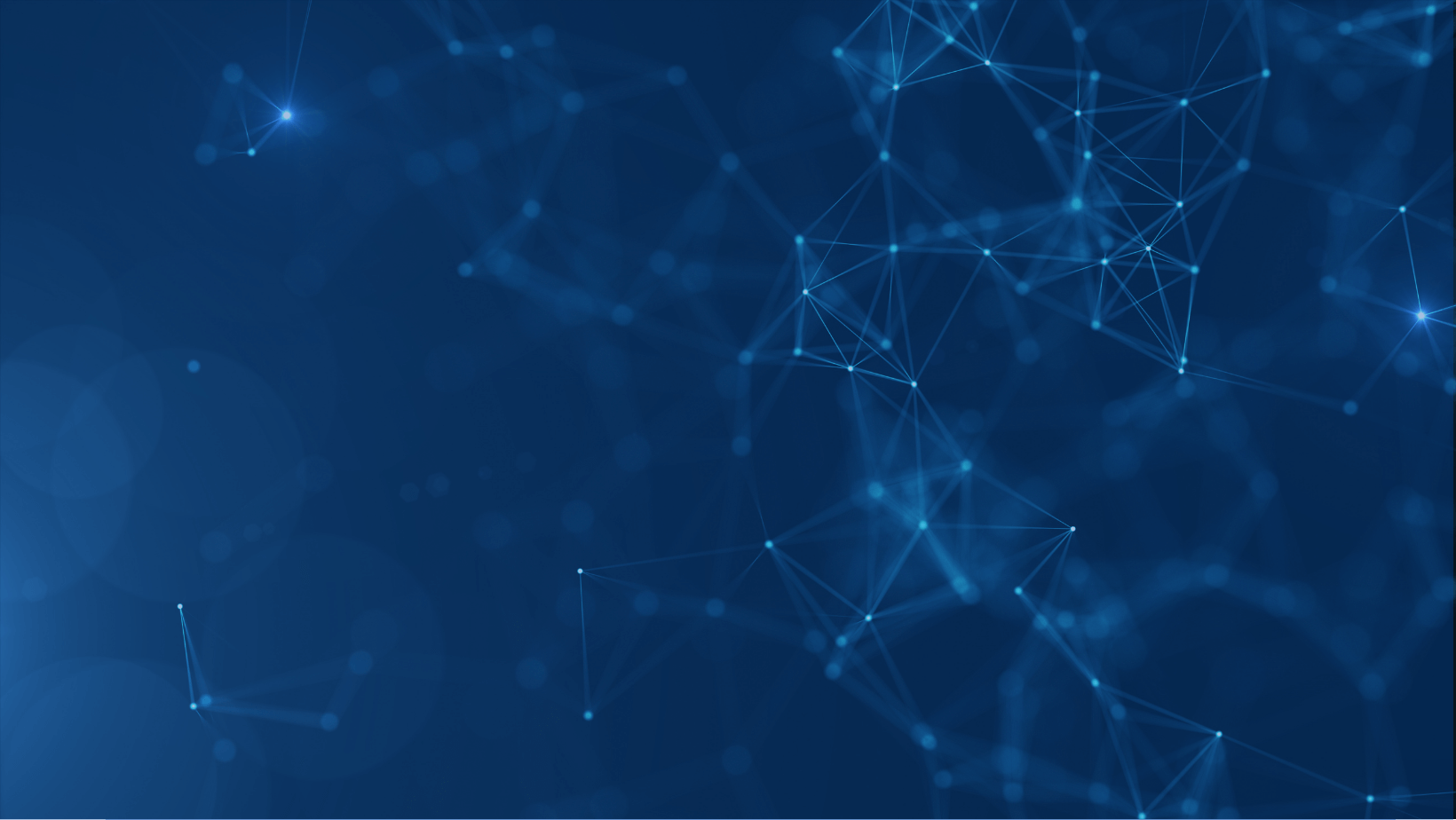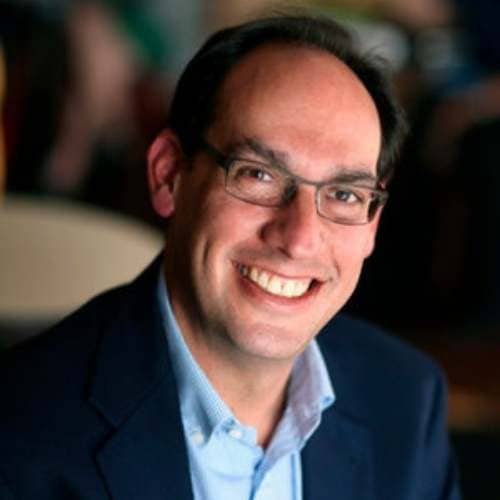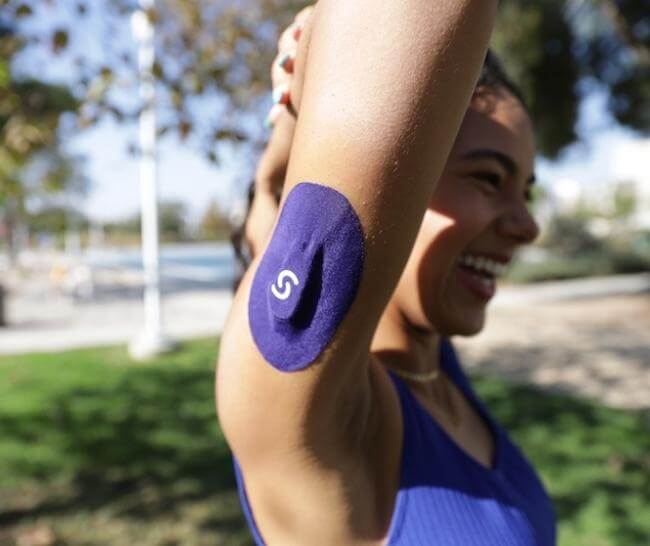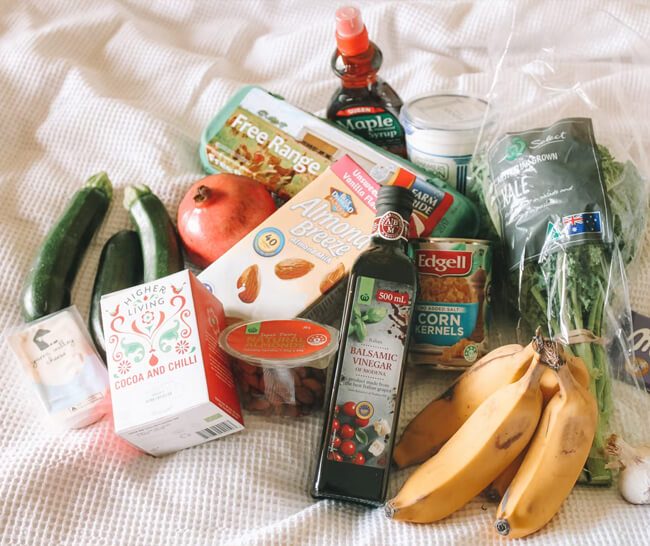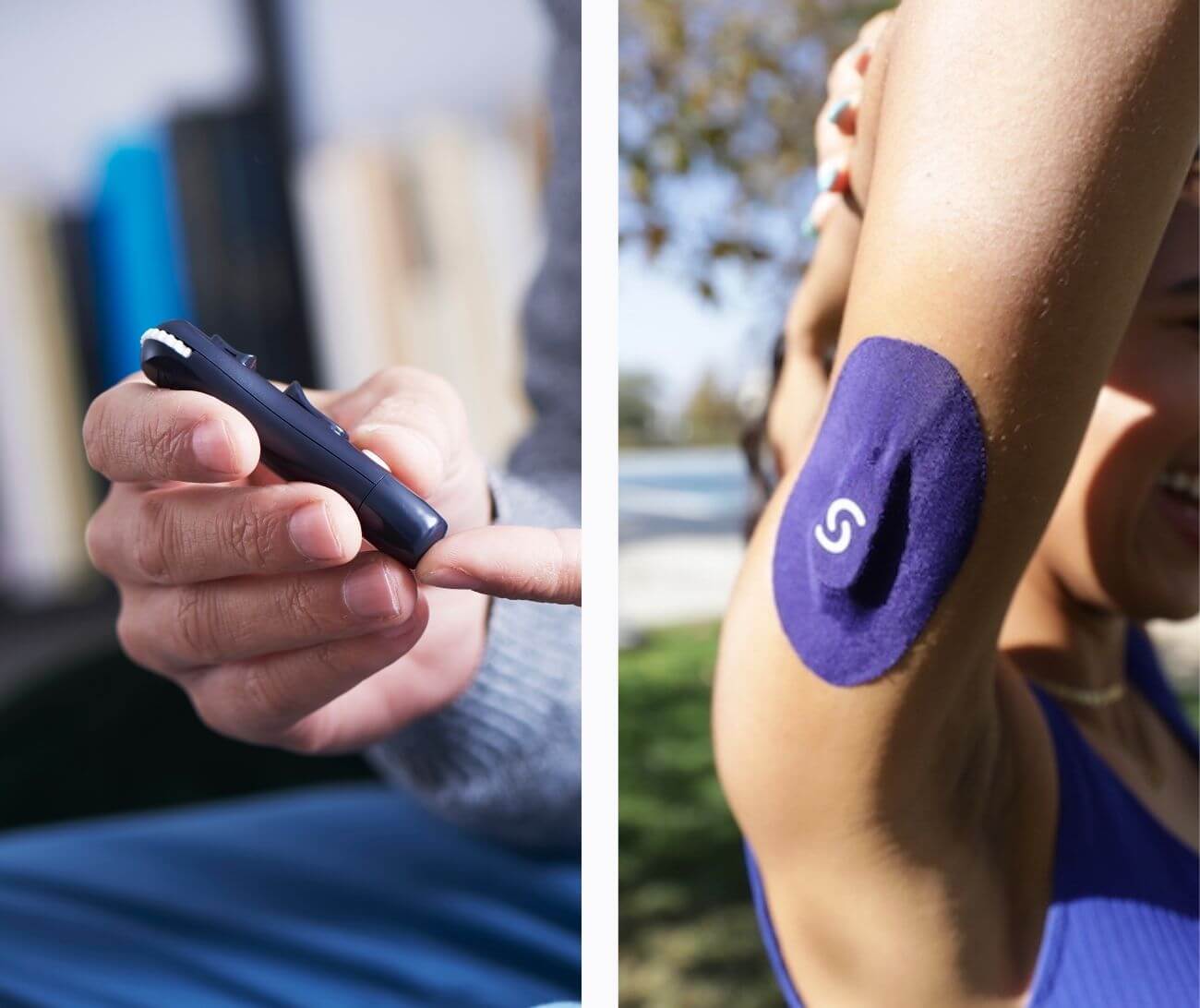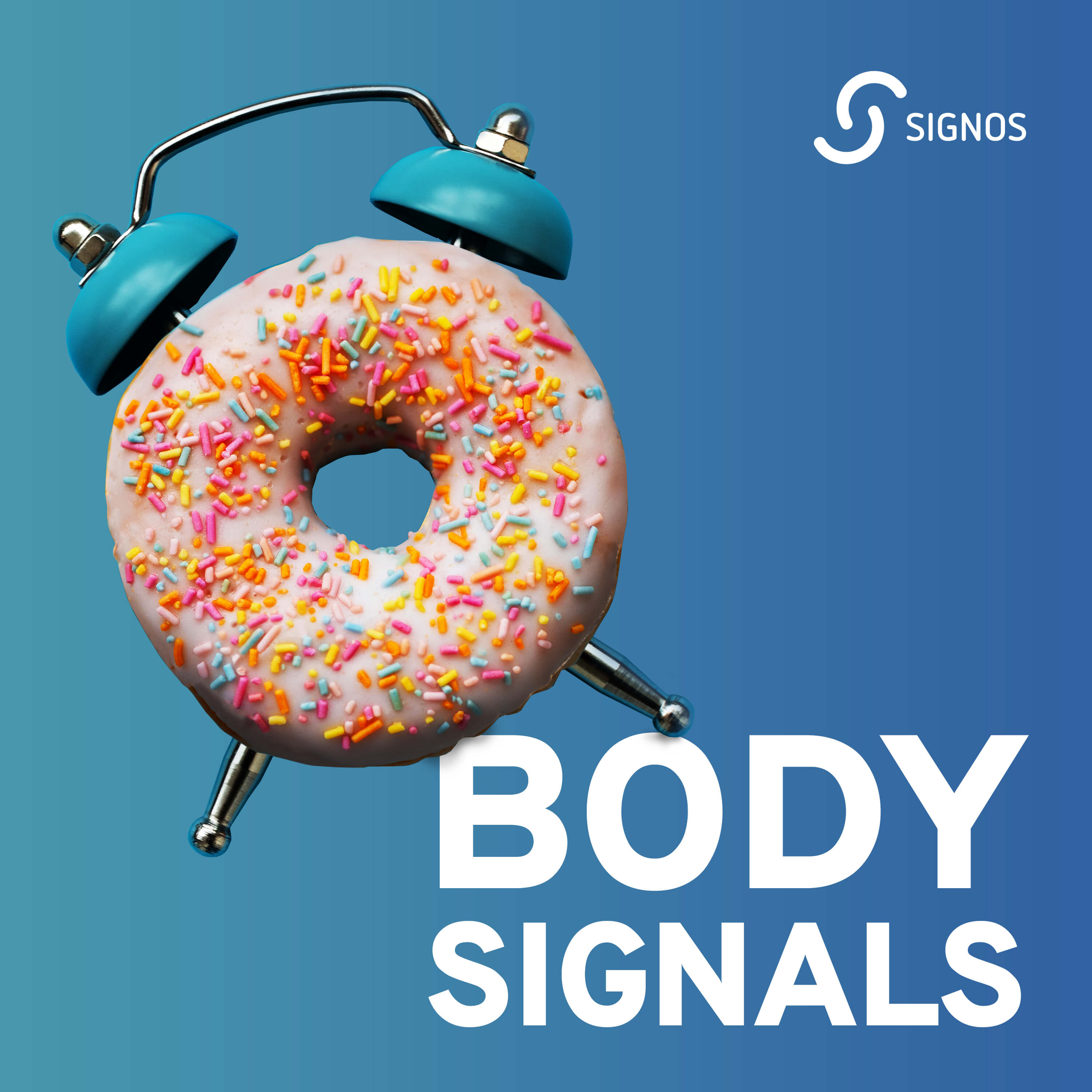Fireside Chat with Signos CEO Sharam Fouladgar-Mercer and Signos Chief Data Scientist Bill Tancer. During this conversation, Sharam and Bill discuss why they started Signos, what are continuous glucose monitors (CGMs), and how CGMs can be key for weight loss.
Bill provides examples of how CGMs can guide you towards finding foods that won't spike your glucose measurement. He shares his own experience of finding out that oatmeal, a breakfast known to keep glucose stable, caused a massive glucose spike for him and what he did to change that.
<p class="pro-tip">Also Read: The Scientific Evidence for Using CGMs for Weight Loss</p>
Full transcript:
Bill Tancer 0:04
Welcome to Body Signals, a Signos podcast. This is season one, Episode one our premier episode.
Sharam Fouladgar-Mercer 0:14
Thanks for joining us on today's podcast. My name is Sharam Fouladgar-Mercer. I'm the CEO and Co-Founder of Signos. Today, it's my pleasure to welcome Bill Tancer, our data and weight loss evangelist as well as our Chief Data Scientist.
Bill Tancer 0:26
Thanks Sharam. It's great to be here.
Sharam Fouladgar-Mercer 0:27
He's written a couple books, one of which is called Click - What Millions of People Are Doing and Why It Matters, it even became a New York Times bestseller. He was the former SVP of Data at Experian/Hitwise, and even wrote a column for Time Magazine. He's a former member of the faculty of the Stanford University Publishing Program, and if you've ever seen the hit ABC show 20/20, an entire segment of the show was dedicated to Bill. And you can even see him on an episode of the HBO hit series Silicon Valley. So Bill, just a little bit of background for our first podcast ever since you'll be hosting from now on. Tell us a little bit about yourself. And also, what is a data evangelist?
Bill Tancer 1:08
Yeah, that's a great question. Data evangelist is something I kind of fell into. Going back to my education, I got a degree in management from University of Florida. That's where my love of numbers started. I had a number of jobs, including being a prosecutor, eventually going into tech, working at an ISP. Then found my myself at a company called Hitwise that analyzed what people were doing on the internet. They had a big sample - about 10 million internet users in the U.S. and 25 million worldwide. Based on this big sample of anonymized data, I started studying what people do when they go online. What do they search for? What sites do they visit? The reason I was hired was mainly to help people with their SEO efforts. But as I started to dig into the data, I became addicted. And, I did come up with a bunch of tactical applications for this massive data set. One day, I was looking at people searching for diets. It was the first blog post I ever wrote when I was at Hitwise, which was later acquired by Experian. I just wanted to test this out, and I showed how people search for diets and the fact that diet searches spike on the first of every year. And those spikes that occur on January 1 only lasts for four days. By January 5, the volume of searches on diets drops dramatically. It was amazing to see that pattern really didn't vary from year to year. It told me there was something really unique that ran through all of us if a pattern can persist like that there's something deeper, and I started to talk about that versus all of these SEO tools that we had built. From that, I think one of the people I work for at the company said you're really an evangelist for data. And that gave me the idea to to coin the term data evangelist, which is something that I did for over twelve years at Hitwise, and then Experian.
Sharam Fouladgar-Mercer 3:17
Great. Tell us a little bit about how you got involved with Signos and CGM and glucose for weight loss.
Bill Tancer 3:25
So Sharam and I go way back. I advised his last company, which is now called Onclusive. I moved down to Los Angeles a couple years ago, and I was up in San Francisco to go to a conference and had the opportunity to have dinner with Sharam. He's a foodie like me, and we went out to have a pizza at this great pizzeria. I forget the name of it. Do you remember?
Sharam Fouladgar-Mercer 3:52
I wish I did, actually,
Bill Tancer 3:53
Oh, man, if I had a continuous glucose monitor on me at that point... Sharam was ordering pizza and bread and slathering the bread with butter. And then he insisted on ordering dessert and had me finished the entire dessert. I'm thinking my glucose would have been in the mid hundreds; maybe 300. But, we were both talking about things that we were working on. We talked a little bit about how I'd lost some weight, but I really wanted to lose more. And I don't think I even told you at the time and I was looking for a way to get a CGM. I'd been reading about these biohackers. I read that Tim Cook was wearing one around the Apple campus. And I was trying to find one, but it seemed like just a lot of work to go through, but I wanted the data. Because in everything I do in my life, I surround myself with data. I've measured, I don't know if I've ever told you this, but I've weighed myself every single day over the last 10 years. I have a graph that's 10 years long. I measure my heart rate when I exercise, and I really wanted to get this insight into blood sugar because I thought I could really advance my weight loss journey if I if I had that kind of data. And then I think in a call that we had a month or two after we had that dinner, you mentioned this startup that you're working on, and it's like, oh, my God, I need to be a part of this. So that's, that's really how we got started.
Sharam Fouladgar-Mercer 5:27
So tell us a little bit about your personal weight loss journey. Because if I'm hearing this for the first time, I'm thinking, Okay, you have not struggled with your weight at all, because you've been measuring it every single day for the last 10 years. But you actually have a personal weight loss journey that you've gone through.
Bill Tancer 5:43
Yeah, I have struggled with my weight, and I would say that I've got an emotional tie to food. I grew up in a family where food is love. And not only that food is something eat (I guess this is maybe a habit I picked up in school) food is something to eat when you're stressed. Food is something you eat when you're bored. And so even though I had a lot of data, I still had trouble breaking that emotional tie that I had with food. My weight - I think I topped out around 210 at one point. And I went to see the doctor. This is after doing a cardiac calcium scan of my heart. He said, "Wow, you really need to weigh what you did in high school." I called my mom right after seeing the doctor. I said, "Mom, what did I weigh in high school?" This is where I get my love of numbers. My mom said, "179 pounds." Wow, I didn't know that she would know exactly what I weighed. That was a long time ago.
Sharam Fouladgar-Mercer 6:45
That seemed like an unrealistic request from the doctor, though.
Bill Tancer 6:51
Absolutely, you know, coming in at 200 to 210. That seemed like I wasn't going to be able to get there. I had gotten down to the 190s. But going all the way down to 179? That seemed like difficult challenge.
Sharam Fouladgar-Mercer 7:09
Going up and down. It sounds like a journey.
Bill Tancer 7:12
Yeah, maybe in the show notes I'll put a screenshot of my graph of my weight loss. It's a roller coaster - it literally just looks like a sine wave actually, from you know, 10 years ago to to like April of this last year of going up and down, up and down, up and down.
Sharam Fouladgar-Mercer 7:33
It's tough. I mean, so many people have gone through this.
Bill Tancer 7:36
I took it hard his saying you you need to lose this weight. Because your calcium score puts you in a very high percentile, or higher risk for having some kind of cardiovascular issue. You would be best served to to get that weight down. And so I tried harder, but still, I couldn't break under 190. And I wasn't getting much lower. That's right before April, right before I put on the first continuous glucose monitor and opened up the Signos app.
Sharam Fouladgar-Mercer 8:14
So at that point, tell us a little bit more. How does Signos use glucose data and other available data sources?
Bill Tancer 8:21
Yes. So first of all, the CGM or continuous glucose monitor - this is just a little device that's placed on your body. I put it on my stomach. It's got this micro filament that measures your interstitial fluids. There's actually glucose circulating in those fluids just like it is in your blood. And that device comes up with an estimation of what your blood glucose is, and we call it glucose measurement. It's not the actual blood glucose, but it's just that interstitial fluid level is very close. So that's the device, used by the Signos platform.
Sharam Fouladgar-Mercer 8:58
And this is how all CGMs work, the way you just described?
Bill Tancer 9:00
Yes all CGMs work that way. Well, there's a difference. You have to be careful, there's a lot of them that are flash glucose monitors that you actually have to pass a phone over to get a reading. A lot of those devices, you get readings every 15 minutes, but you have to remember to wave your phone over the device. This one that we're using is an actual continuous glucose monitor. It's sending a reading every five minutes to the phone so you're getting a higher resolution of data. And you also don't have to remember to scan it, which is a big deal, especially for things like sleep. I think with a lot of flash monitors, you have to scan every eight hours. If you're sleeping over that, you might lose a ton of data. So this is a CGM. That's part of the the platform. The other part is the software and the application that we've been building.
The software has some components that depend on AI (artificial intelligence) and machine learning to take in all the glucose data that's being gathered. And along with it, if you're wearing a fitness monitor or an Apple watch, it's taking heart rate data, and we're asking you for a food log. So it's taking stock of what you're eating, and all of the macro components of the things that you're eating. If if it's available, we're getting sleep data. All of that's combined into this algorithm that's being generated by the machine learning engine to come up with suggestions for you in terms of what foods you could stay away from, or what foods you can substitute for other foods, and how you can integrate exercise into your day to minimize blood glucose spikes. That's what is really the great thinking behind this solution - that if we can dampen those spikes for your blood glucose, we can keep your body from releasing insulin. Insulin takes some of that sugar that's circulating in your bloodstream, and stores it into fat. If we can minimize the times that your insulin spikes and the degree to which it spikes, based on science, then we can help you lose weight.
{{mid-cta}}
As a result, I've been wearing this since April. So I was at 190. I had still in my head, the doctor saying you need to be down to - according to my mom - 179 pounds. I think it was within like three and a half weeks, I had hit 178. And then I got all the way down to 170. Now I'm actually using this device to help to build muscle and so my weight has gone a little bit up. It's like 175 right now, but my body composition, my body fat percentage is dropping. So I'm getting more lean muscle, and I'm feeling fitter - I'm feeling the best that I've felt since high school. And I think a lot of it has to do with controlling blood sugar. I should add here that I didn't lose that weight through calorie restriction, I didn't really cut back on the amount of food I was eating at all, I just changed what I was eating. And it felt pretty effortless. It actually, it wasn't just effortless. For me, it was fun. I got addicted to the graph that's in the Signos app, seeing what my glucose measurement was at any particular time and then seeing what would happen after I eat a meal. And then having the power to play with what was in that meal and change a few things and see if I could make the glucose measurement a little bit lower the next time and then a little bit lower the next time after that.
I didn't I didn't feel like I was on a diet because I wasn't on a diet. What I was doing was making lifestyle changes - what what one of our co-founders Dr. Dixon talks about - micro changes. I was making these little teeny micro changes in what I was eating. And that was it. I think it was in the first couple of days of using this that I called you up. At first I said I wanted to be an advisor to Signos. But then I said no, no, I want to work full time. Put me in, I'm in. Because I think this is really a paradigm shift. So much has been written about diets. And we're so obsessed as a society about diets. No one has really given us a way to make lifestyle changes that don't feel painful. And this doesn't feel painful at all. In fact, it feels empowering. And yeah, I've gone off track, but I'm very passionate about this topic.
Sharam Fouladgar-Mercer 13:54
No, look, all of us at the company have gone through this. You know, my own personal weight loss journey mimics yours a little bit in terms of I've been up and down and up and down for various parts of my life. And you know what, I lost 30 pounds using this. I had a similar experience. But I think the thing that's quite interesting is your talk about the hope people have when they go through a weight loss journey, and you actually wrote a part of your book on this. I remember a chapter in Click about weight loss in particular.
Bill Tancer 14:34
Yeah, I forgot to mention it, Click. I wrote a book back when I was at Experian. This was part of my data evangelism - I decided to take all the stories I collected and put them into a book which which did really well.
Sharam Fouladgar-Mercer 14:52
Bill's very modest. It actually was a New York Times best-selling book.
Bill Tancer 14:56
It did well. Thank you. I didn't want to say that. That would sound like I was bragging. I think it was the second chapter in the book, I talked about this concept of false hope syndrome. And it was about what I had seen in that new year's resolution data, but then digging a little deeper to find just how people search for diets and how people were looking for quick fixes to their weight loss problem. They weren't looking for lifestyle changes at all. In fact, I remember from looking at the data, the searches for diets, I think, was double or triple any searches around exercise around New Year's people didn't want to put in an effort, they just wanted to lose the weight. And every year that I analyzed the data, it would go from, you know, lose 10 pounds in 30 days to lose 10 pounds in 10 days to lose 10 pounds in the next 10 minutes. It just became more and more unrealistic. There is a this phrase of false hopes syndrome that was coined by a professor at University of Toronto, she did a couple of experiments. But what she found was that this repeating pattern every year of people looking for diets and then failing at them, created the syndrome, where they kept coming back every year to try these fad diets. And what she found was that people entered a diet with unrealistic expectation, they actually achieved something in the very beginning. And usually it was attributed to weight loss from water weight. And then the diet would fail because they would fall off it, it was too restrictive, or that water loss was no longer something that showed up on the scale, and they abandon the diet. They were just repeating this pattern year after year after year, expecting to get some change. And like I've said before, this is probably one of the most important points to me is that Signos is not a diet and will never be a diet. It's about lifestyle change. It's about making a permanent change. It is a bunch of steps - micro steps - that you can take changing little things about what you eat, and how you exercise and how you deal with stress and get better sleep. And all of those things together really help you lose weight and become healthier.
Sharam Fouladgar-Mercer 17:17
Tell us a little bit about your own experience.
Bill Tancer 17:21
Yeah, so I've told this story a bunch, and I apologize if anyone's heard this before, but the very first day I put on the sensor, I had what I've been having for two years for breakfast, I eat oatmeal. I eat it because I researched it, I went to a bunch of research papers that said that eating oatmeal, steel cut oatmeal, without any added sugar and with a couple of additions, I found people recommended putting in some berries that don't spike your blood sugar, banana, good potassium fiber, almond butter to add some fat, this whole combined thing was supposed to help me lose weight. And I've been eating it for two years. So I put on that sensor, and the very first thing I saw after I ate my first meal with this continuous stream of glucose data - was I spiked to 187. Now the normal range, what you want to keep your your glucose in is around you know 80 to 120. When you eat a meal, maybe you might go up to 140 but you should be able to come down quickly. 187 is definitely something that's going to cause you to gain some weight. And, I've been eating this exact same breakfast for two years. I thought it was an error. So I ripped the sensor off. And I called you, and you said well, we built this function into the app that actually will show you things like how you can use exercise to minimize that spike. If you just follow the app, you can just follow its prompts and do a little bit of cardio after you eat and and that should fix it. So, I put on another sensor. Next morning ate the exact same meal: oatmeal with bananas, almond butter, flaxseed meal blueberries. And right after I consulted the app, it said to do some cardio. It was actually a short cardio - 15 minutes getting my heart rate up to I think it was between 60-70% of your max heart rate. Looking at the graph, there was no spike at all. It was completely flat. I think that was the day I called you up and said I want to go full time. And I mean it's amazing that for two years to eat this exact same breakfast, and that was probably one of the things that was causing me to gain the most weight.
Sharam Fouladgar-Mercer 19:51
It's really kind of fascinating because I've told you this but when I have oatmeal, I actually have the opposite glucose response. It's a great example of how it's not that one food is right or wrong, it's just that our bodies are so different.
Bill Tancer 20:06
I'm so glad that you mentioned that there was an article on this. It was a research study done from the Weitzman Institute in Israel where they had taken I can't remember the n number of the participants, but it was a pretty large group of people. They studied their blood sugar, they put a CGM on everybody. And then they gave them different meals. What they found was that people responded completely differently, or very differently to the same foods. I think the examples they used were pizza and ice cream, and that you could take subject a, he spiked on pizza, but not an ice cream. Subject B did not spike on pizza, but did ice cream. I think that's one of the other things that makes this technology revolutionary - is that we can really personalize our lifestyle changes. We can find the foods that affect us the most. When I did the analysis on that bowl of oatmeal, it was the bananas that were causing the spike. So I had now two ways I could deal with that oatmeal: I could eat what I wanted to eat, which was that exact combination, because I was kind of used to it and exercise afterwards. Or, I could just remove the banana. Because of all the things in that bowl, that's the thing that had the most natural sugar. So, I can make that one little change. But what's interesting is that you might not spike at all if you ate the same thing. Oatmeal doesn't affect you (Sharam) at all, maybe bananas don't affect you at all. When we tried to make lifestyle changes in the past, we could just go to all of these recommendations that averaged out how everyone responds to foods. And it's not the most efficient way to find the right triggers to get yourself on track for a very efficient weight loss journey.
Sharam Fouladgar-Mercer 21:55
And your body changes over time. Even on a on a daily basis, there are different factors that occur, whether it's sleep, or stress, or whatever it may be, that will affect your body's response to eating the same food. We'll talk more about other findings that you've had through that. But I think it's important to bring that up that people are different, and that you yourself will be different even on a daily basis.
Bill Tancer 22:21
Yeah, absolutely. There are so many different examples that I could pull out on that. And again, I know I've made this point before, but it's about that empowering feeling of knowing that I can personally make these little changes and see the results immediately versus what I did before I started using Signos, which is just look at the scale every morning. So I'd go, and I'd weigh myself at the exact same time every morning. Because I'm kind of OCD like that. And if my weight went up, I don't know if it's because there was a lot of salt in the food I'd had...maybe I was retaining more water than normal. I didn't know what it was specifically in that day. It may be because I didn't exercise that previous day that my weight went up. I just had to make some assumptions. And I didn't really feel in control. Which is why maybe my weight did kind of go up and down over the years. I didn't know what which levers to pull to make the changes.
Sharam Fouladgar-Mercer 23:25
Yeah, that's tough, because you know, your normal diet plan will tell you to weigh yourself once a week. So just by virtue of the fact that it sounded like you were doing all the right things. It's still difficult to to actually lose weight and your personal journey of going up and down. Even doing all the "right things" you thought were leading you towards weight loss, it was still wasn't moving the needle.
Bill Tancer 23:50
Yeah, and you know, one of the other changes that I made once I had on the the CGM, and I was using Signos, was that I didn't realize how much I was snacking. If I'm looking at that graph and find myself upstairs and there's a bag of Trader Joe's cookies...In the past I would have started eating those just as a little snack and had no idea how much those those little cookies would spike my blood glucose. I think I had just one of them as a test after I put on the CGM and I was up in the 180s from one small cookie. I used to snack a lot, and I mentioned emotional eating before, and this is the other thing that I think is very empowering about Signos. Sometimes I would just eat absentmindedly. It was like something I did to take a break. If I had worked a long period of time, I might go and reward myself by going upstairs and getting a cookie or eating something, you know, a couple of chips or something. I didn't really need that stuff, and now that I'm looking at my blood glucose, I'm realizing I'm not even that hungry. I didn't even plan for cutting out a lot of that snacking during the day, but I did because I was so focused on keeping my blood glucose nice and steady and flat in between meals.
Sharam Fouladgar-Mercer 25:19
Love it. That's, that's great. So tell us a little bit about what has been your most surprising finding or most surprising findings.
Bill Tancer 25:30
So beyond that oatmeal, which was pretty surprising...Some fun things that we discovered and there's actually some research studies on this, but playing around with food order, and food combinations. One of our advisors, Paul diTuro had mentioned that it'd be a good idea to try and eat some greens with an acid. I use like a balsamic vinegar, wait 10 minutes and then eat something with carbs and see how that might change your blood sugar. So on Sundays, my wife goes to the farmers market down the street, and she gets these vegan croissants that are amazing. Don't let the word vegan scare you. These things are full of saturated fat. They're incredibly carb-y. And I would eat these every Sunday, just because it was kind of like the one thing I allowed myself to do. My blood sugar would spike like the oatmeal into the 180s. One Sunday, after seeing Paul's deck and reading the research study that he had footnoted on that deck, I had some arugula with a balsamic vinegar about 10 minutes before eating a croissant. And when I did that, there was absolutely no spike whatsoever. And this was exciting to me that I can you know, still enjoy something like that and maintain my weight loss just by adding, you know, a simple salad. Some dark greens and an acid like a vinegar - I could do something like that. So that was surprising.
Other things I found surprising...I've been paying close attention to my sleep. If I had a poor night's sleep, the night before, food that I didn't spike on, I would spike on. And I didn't understand just how important sleep was in maintaining a nice steady glucose level. But it is another really interesting thing. And this is a kind of an experiment I ran (I like to do a lot of experiments on myself) kind of an n equals one kind of guy. So, I would take that oatmeal that I had now kind of fine-tuned, you know, I wouldn't get any spike whatsoever. I eat it at eight in the morning when I normally would. And then the next day, I'd eat it at three in the afternoon. I was spiking moderate spikes at three in the afternoon, no spike whatsoever, first thing in the morning. I found some some research that there is connection with our circadian rhythms and our glucose levels and the body. For some of us, it's not everybody. But the body usually is better equipped to handle carbs in the morning than it is in the afternoon. We've heard a lot of advice about eating your bigger meals in the morning and then eating smaller meals at night. But for me it was even more specific than that, that if I wanted to have something that had some carbs in it, it was better to front load that first thing in the morning. So yeah, it's all of that. And then you mentioned before the personal nature of Signos, the fact that we're all comparing notes. I love working on this team. Because in our own little office messaging app, we're all sharing screen grabs of the things that spike us and the things that don't. And what's so amazing to see is someone will have a food that I know never ever spikes me. And they're getting these massive spikes, and I'll share something that spikes me and doesn't spike them. So it's really that individual nature that is fascinating. And it's actionable, you can do something with it.
Sharam Fouladgar-Mercer 29:07
Some of the stuff you're talking about with the croissants, for example, to me when I hear that for the first time, it just sounds crazy. And the fact that that works is pretty amazing. Tell us what are some of the experiences or experiments that you're working on right now?
Bill Tancer 29:25
Yes, there's a lot of different things that I'm working on. I'm always doing these one-off tests. But then also for the company, I'm just diving into the research, and seeing if I can prove out some of the things that others have written about. I do a lot of hypothesis testing. So you know, the way my mind works is let me come up with a hypothesis. I'll test it on myself first, and see if it works. So looking at things like how reducing stress can affect your glucose is a big one. Doing things like breath work and seeing if I can reduce stress by doing that. I'm testing something right now called resonant breathing, which is using data again, and a heart rate monitor and HRV, to find just the exact breathing pattern that's perfect for me and seeing if I can bring my heart rate variability up. And that's means I'm, for the most part, my stress levels are coming down and then seeing how that affects my blood glucose. I have a lot of fun experiments, too, like I'll tease a little blog post we're going to be writing in the near future. But this idea of cephalic insulin response, I was listening to a podcast where somebody had mentioned this research study that hypothesized that just walking by a Cinnabon in a mall might make you fat because your brain is going to pick up on the smell and start to actually release insulin in expectation of you possibly eating. But that without you ever eating it, you could still get that insulin spike. So I'm going to run some experiments on that and write about it in our blog, that's going to be coming up soon. And I'm also looking at different training zones right now. I'm having a lot of fun - one of the byproducts of getting involved with Signos is that I have become more and more fit and more interested in fitness just as kind of a natural result of doing this. So in this, this COVID age where I can't go to my gym anymore, I've got a rower in the basement, and I decided that that was going to be my tool to stay fit during this time. At first I would just get on and mindlessly row for, you know, 20-30 minutes, and then I started to get better and better as my fitness improved, then I started to actually make goals for myself in terms of times for 2K time trials. Now I'm running experiments as to how I can reduce my body fat because I'm at my target weight. I want to increase my muscle mass by finding just the right heart rate zones to work at. And again, if these hypotheses prove true, like they do in the research, slowly we'll look at the data and find if there's ways that we can launch these experiments and help people really continue their journey. I just wanted to add in closing that, I think I've been so fortunate to find the job here at Signos. It allows me to use my skills as a data analyst coupled with my passion for health and fitness and all the while get fit at the same time and help our members get fit. I also want to say that I'm just so excited to be hosting our Body Signals podcast going forward.
Sharam Fouladgar-Mercer 32:55
I love it. This is been wonderful to have you on even more excited to have you hosting the future podcast sessions. I just want to say thanks for sharing the story, and coming on and telling us, telling everyone all about your background.
Bill Tancer 33:13
Thanks Sharam, and thanks everyone for listening to Body Signals, a Signos podcast. To learn more about Signos, please visit us at Signos.com where you can find more great content our blog and show notes for this episode and future episodes. If you enjoyed this podcast please subscribe.
- Item 1
- Item 2
- item 3

